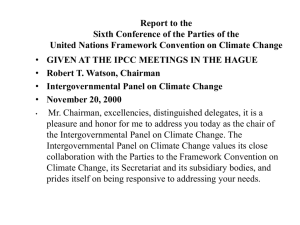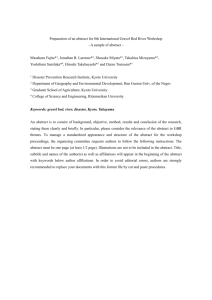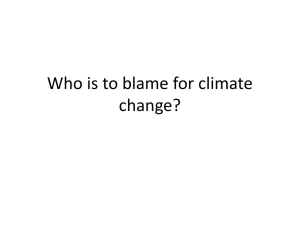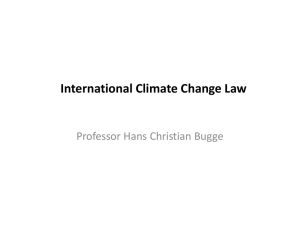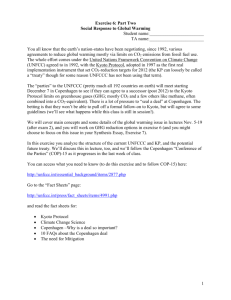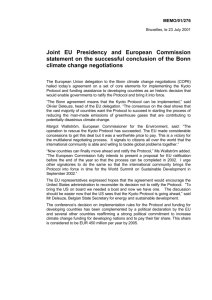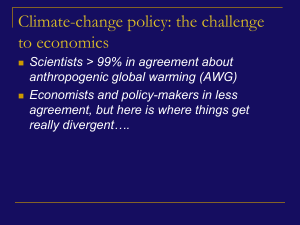Outline - Carbon Finance at the World Bank
advertisement
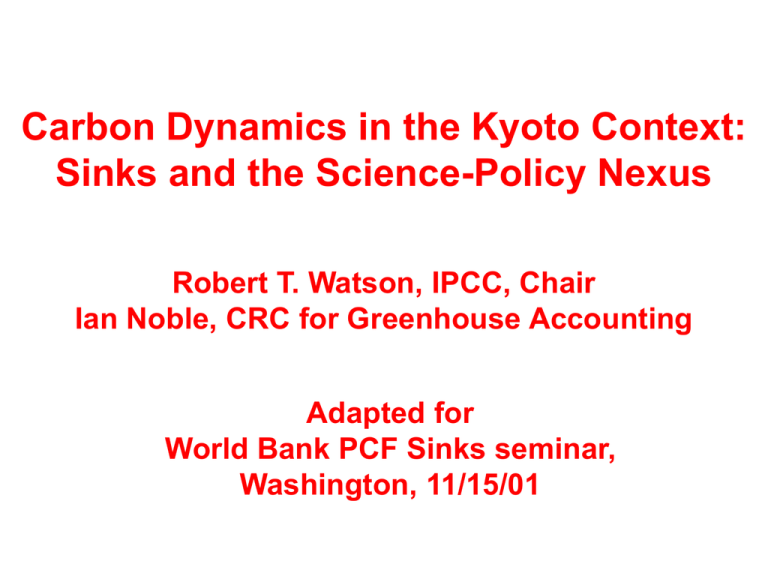
Carbon Dynamics in the Kyoto Context: Sinks and the Science-Policy Nexus Robert T. Watson, IPCC, Chair Ian Noble, CRC for Greenhouse Accounting Adapted for World Bank PCF Sinks seminar, Washington, 11/15/01 Variations of the Earth’s Surface Temperature: 1000 to 2100 Atmosphere 3.2 750 63.0 The Global Carbon Cycle (1990s) 6.3 1.6 60 500 Plants Soil Fossil Deposits About 4,100 91.7 90 2000 0.7 Oceans 38,400 Units Gt C Gt C y -1 Global Carbon Cycle For every 1 t of carbon emitted from fossil fuels 10 t are taken up and emitted by terrestrial ecosystems 7 t are taken up and emitted and by ocean ecosystems ¼ t is emitted from land clearing The Balance each year... 6.3 Gt from fossil emissions ca. 1.6 Gt emitted from land-clearing 1.7 Gt net uptake into ocean systems and c. 3.0 Gt into terrestrial systems Leaving a net 3.2 Gt in the atmosphere We cannot ignore sinks in UNFCCC Emissions and uptakes since 1800 (Gt C) 140 Land use change emissions 115 Oceans Uptake 110 265 Fossil emissions Terrestrial Uptake 180 Atmosphere Uptake Carbon budget Atmospheric increase Fossil emissions Ocean - Atmosphere flux Land – Atmosphere flux Land-use Change Residual terrestrial sink 1980s +3.3 ± 0.1 +5.4 ± 0.3 -1.9 ± 0.6 -0.2 ± 0.7 1.7 ± ? -1.9 ± ? 1990s +3.2 ± 0.1 +6.3 ± 0.4 -1.7 ± 0.5 -1.4 ± 0.7 ?1.6 ± 0.8 ? ?-3.0 ?? The terrestrial carbon sink appears to be increasing Why is the Terrestrial Carbon Pool Increasing? CO2 fertilization Warming Nitrogen deposition Age structure changes Fan et al (1998) - Inverse analysis USA (south of 51 deg N) is net sink of 1.4 Gt C / y Emissions & sinks from land-use in USA Houghton et al (2000). Global Ecology & Biogeography 9, 145 Sink The US Terrestrial Carbon budget Fan et al 1998 (88-92) 1,400 Mt C / y Houghton et al 2001 (70-90s) 300 Mt C / y Pacala et al 2001 (80-90) 370 to 710 Mt C / y Inverse results Bousquet (North America) -400 to 1600 Mt C / y 700 to 800 Mt C / y Schimel et al [CO2 effect] (80-93) c. 80 Mt C / y Why is the Terrestrial Carbon Pool Increasing? USA is a net sink of 300 to 700+ Mt C / y Most sink capacity comes from changes in age structures, fire reduction etc Is this true elsewhere? China, Australia, Europe Are forests responding to elevated CO2? Many small scale experiments show variable but often positive responses Results from Duke FACE experiment Most additional carbon enters short-lived pools, thus the increase in carbon density is not as substantial as some may have assumed Nutrient limitations may limit continued growth enhancement Can we improve estimates of carbon sinks? Kyoto Protocol requires transparency and verifiability Inverse techniques Huge inconsistencies and debate Future improvements, multiple constraints and [CO2] column estimates Challenge for IGBP Carbon Project How will uptakes and emissions from terrestrial ecosystems change over the next century? IGBP model comparison Sink Gt C / y Changes in terrestrial “can” dwarf the changes brought about by Kyoto processes Hadley Models Large feedback with drying out of tropical (Amazonian) forests and subsequent release of carbon in fires and soil respiration Does this mean that planting trees could “backfire” on us? Efforts to establish woody vegetation on areas of low carbon will almost always yield a net carbon gain for many decades to centuries Exceptions include heavy use of fertilisers (leading to other GHGs) major soil disturbance at establishment creating fire hazards that affect other vegetation Does this mean that planting trees could “backfire” on us?: 2 Opportunities for carbon sequestration in vegetation are likely to be modest Reforestation and other revegetation will rarely take place for its carbon value alone Even a few tonnes of carbon per hectare can make major differences to some land rehabilitation projects What does sink saturation mean to the Kytoto Protocol arrangements? From about the middle of this century it will become increasingly difficult to maintain or reduce greenhouse gas concentrations in the atmopshere We have a 1.6 to 3.0 Gt C /y “free-ride” that may peak at about 5 Gt C / y After that it will become increasingly more difficult to maintain the status quo Challenges in Modelling Processes Interactions of CO2, temperature, nitrogen and water Scaling Landscape issues & disturbances Global base-data Carbon Ecology Will ecosystems Collapse Migrate Modify in situ? How will carbon storage change as ecosystems change? Can carbon fluxes be measured “topdown” - e.g. inverse approaches? The Kyoto Protocol The Challenge of Mitigation The near-term challenge is to achieve the Kyoto targets The longer-term challenge is to meet the objectives of Article 2 of the UNFCCC, i.e., stabilization of GHG concentrations in the atmosphere at a level that would prevent dangerous anthropogenic interference with the climate system food security ecological systems and sustainable economic development Kyoto Process: meeting greenhouse gas reduction targets UNFCCC Convention: Rio, 1992 Kyoto Protocol: December 1997 Kyoto: 5.2% reduction below 1990 baseline by 1st period of 2008-12. Targets for developed countries and countries with economies in transition (“Annex I”). No target for dev’g ctries. Reduction: About 0.2 GtC/y below 1990 but 0.7 GtC/y below “business-as-usual” projections The Short-term Challenge Percentage Change in Emissions from 1990 to 2010 130% 125% 120% Parties' projections 115% SRES A1F1 110% SRES A1T Evolution in % Annex II 105% SRES A1B 100% SRES A2 Annex I 95% SRES B1 SRES B2 90% OECD 85% IEA EIT US source LG 80% US source REF 75% US source HG 70% EU source 65% Average 60% 55% 50% 1990 1995 2000 2005 2010 The Long-term Challenge Carbon emissions and stabilization scenarios The Challenge of Mitigation If governments decide to stabilize the atmospheric concentration of carbon dioxide at 550ppm (about twice the pre-industrial level), global emissions would have to peak by about 2025 and fall below current levels by 2040 to 2070. This would mean that all regions would have to deviate from most “business-as-usual”scenarios within a few decades Key Issues for the Kyoto Protocol Flexible Mechanisms There are three flexibility mechanisms Article 6 - Joint Implementation among Annex I Parties - these are project-based activities Article 12 - The Clean Development Mechanism project-based activities between Annex I Parties and developing countries Article 17 - Emissions rights trading among Annex I countries Because carbon abatement costs are much lower in most developing countries, carbon trading allows: reduced costs for industrialized countries technology transfer to developing countries financial flows to developing countries Key Issues for the Kyoto Protocol Flexible Mechanisms (Art. 6, 12 and 17) Capped or uncapped? (EU and many developing countries want a cap in contrast to the US: will affect the size of market and the cost to Annex I countries) - current text states that obligations should be chiefly met through domestic actions Should hot-air trading with Russian Federation be allowed? - allowed within a strict trading cap Eligibility of LULUCF activities in CDM? - limited to afforestation and reforestation liability? (if a seller fails to deliver, i.e., seller vs buyer beware) adaptation fee - CDM or all three mechanisms? (affects size of adaptation fund, hence the ability to mainstream climate change into relevant sectors) - currently limited to CDM Key Conclusions of IPCC WG III Without trading, Annex B costs of complying with the Kyoto Protocol, range from $150-600/tC (i.e., 0.2 - 2% loss of GDP). With full Annex B trading, the costs are reduced to $15-150/tC (i.e., 0.1 - 1% loss of GDP) These costs could further reduced with use of: the Clean Development Mechanism sinks mixture of greenhouse gases ancillary benefits and efficient tax recycling If all cost reduction activities could be realized then GDP growth rates would only have slowed by a few hundreds of a percent per year Key Issues for the Kyoto Protocol Land-Use, Land-Use Change and Forestry Topics covered in this presentation include: How have LULUCF activities been included in the Kyoto Protocol? What are the key decisions? What is the potential of LULUCF activities to reduce net emissions Key Issues for the Kyoto Protocol Land-Use, Land-Use Change and Forestry Definitions of a forest, afforestation, reforestation and deforestation How to address the harvesting/regeneration cycle and aggradation/ degradation (Art. 3.3 or 3.4) How to deal with permanence under Articles 3.3 and 3.4 What activities are eligible under Article 3.4 whether to limit credits under Article 3.4 whether business-as-usual uptake can be credited What needs to be monitored Which, if any, LULUCF activities are eligible in the CDM afforestation, reforestation, slowing deforestation, forest/rangeland/cropland management, agroforestry how to address the issues of permanence, baselines, leakage and sustainability criteria under the CDM Interpretations of Article 3.4 Narrow definition Broad definition Forest Management Cropland Management Grazing land Management USA definition Full carbon accounting All stocks across all carbon pools If applied to all land in all countries then the accounting would produce the “Net terrestrial uptake” of about 1.4 GtC y-1 (IPCC TAR) without any additional effort to reduce emissions or increase sinks Assuming emissions from tropical deforestation are 1.6 GtC y-1, suggests global uptake of about 3 GtC y-1 Assuming 50% of the uptake is at mid- and high latitudes, this would allow Annex I Parties to claim an annual credit of between about 1.5 GtC y-1 due to the residual uptake because of improved management practices pre-1990, carbon dioxide and nitrogen fertilization effect and climate change. Current text would limit this credit by discounting by 85%. Direct Human-induced “For activities that involve land-use changes (e.g., from grassland/pasture to forest) it may be very difficult, if not impossible, to distinguish with present scientific tools that portion of the observed stock change that is directly human-induced from that portion that is caused by indirect and natural factors.” Emissions and removals from natural causes such as El Niño may be large compared with commitments For land-management changes (e.g., tillage to no-till agriculture), it should be feasible to distinguish between direct and indirect human-induced components, but not to separate out natural factors Permanence “Sinks” are potentially reversible through human activities, disturbances, or environmental change, including climate change. This is a more critical issue than for activities in other sectors, e.g., the energy sector. A pragmatic solution... (consistent with the current text) ensure that any credit for enhanced carbon stocks is balanced by accounting for any subsequent reductions in those carbon stocks, regardless of the cause. Annual C sequestration potential (GtC/y) improvement of management within cover type new activities since 1990 I Annex 1 Urban land management Global Rice Paddies Agroforestry Grazing land management Cropland management Forest management 0 0.1 0.2 0.3 Contains a best estimate of the rate of uptake of these activities by 2010 (vary between 3% to 80%) -- current text would inhibit investment under Article 3.4 because forest management because is discounted 85% Annual C sequestration potential (GtC/y) Transformation between cover types Annex 1 Degraded land restoration Global Wetland restoration Degraded agriculture to agroforest Cropland to grassland 0 0.1 0.2 0.3 0.4 0.5 Key Issues for the Kyoto Protocol Article 12: CDM Emission reductions ... shall be certified by operational entities to be designated by the Conference of the Parties... on the basis of: (a) Voluntary participation approved by each Party involved; (b) Real, measurable, and long-term benefits related to the mitigation of climate change; and (c) Reductions in emissions that are additional to any that would occur in the absence of the certified project activity. Does this include sinks? Does it refer to gross or net emissions? Current text suggests allowing afforestation and reforestation, but no other LULUCF activities Key Issues for the Kyoto Protocol The Clean Development Mechanism What will be included: COP-7 text allows afforestation and reforestation But rules & modalities need be agreed first Not allow avoided deforestation or other land management Key issues, especially for avoided deforestation, include: baselines - issue of additionality local, regional or national sectoral business-as-usual or ?????? permanence time-limited credits, avoiding national sovereignty issues leakage local, regional or national sectoral baselines (does not avoid transboundary leakage) sustainable development criteria monitoring project-based or national systems will need to be developed Sustainable Development Criteria LULUCF activites and projects can have a broad range of environmental, social and economic impacts, e.g. biodiversity forests, soils, water resources food, fiber, fuel employment, health, poverty, equity System of criteria and indicators (c&i) could be valuable to compare sustainable development impacts across LULUCF alternatives If sustainable development criteria vary significantly across countries or regions, may be incentives to locate activities and projects in areas with less stringent criteria. Potential for international trading in sinks (Pronk proposal Apr 2001, using Aug 1 submitted data) Credits under Art 3.4 Unlikely Purchases Potential Purchases 70 Mt C per year 60 50 40 30 20 10 0 Estimated potential trade of about 20 MtC/yr through all three mechanisms Conclusion Climate change is occurring, in part because of human activities, and further human-induced climate change is inevitable Most people will be adversely affected by climate change, particularly the poor within developing countries Climate change is a serious environmental/development issue that requires action to limit greenhouse gases now, recognizing both short-and long-term objectives Climate change mitigation and adaptation technologies and policies need to be integrated into national development plans Technologies and policies are available to address climate change in a cost-effective manner Governments, the private sector,civil society, the media and the scientific community all have critical roles in addressing the issue of climate change Policy-relevant research and assessments are needed for informed policy formulation - need to communicate results in a clearer manner
